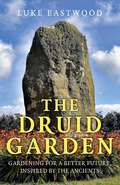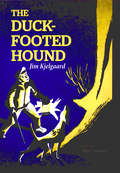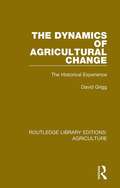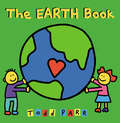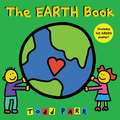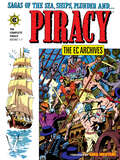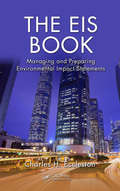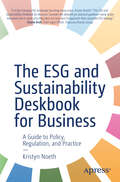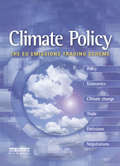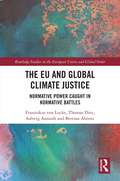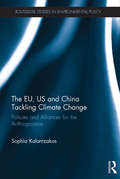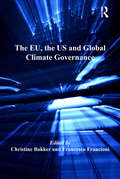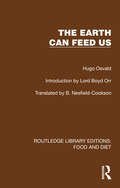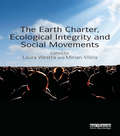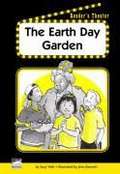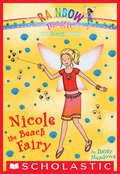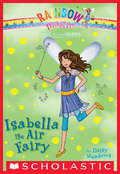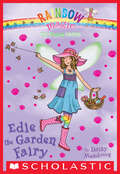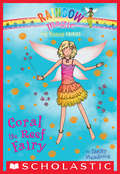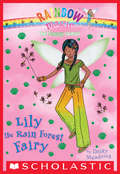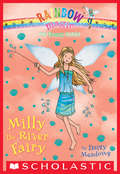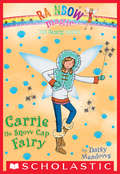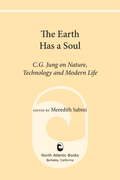- Table View
- List View
The Druid Garden: Gardening For A Better Future, Inspired By The Ancients
by Luke EastwoodIn this age of high technology, GM foods and industrial farming, many people are looking for an alternative way to live, that honours and respects the natural world. The Druid Garden mines the deep seem of gardening through the ages and alternative modern developments, to bring the reader a method of gardening that is truly in touch with the Earth. Drawing on the knowledge of the Druids and other ancient cultures, Luke Eastwood has created a practical guide to organic and natural methods that are proven to work. Advice for the total beginner, through to the experienced, ties together Druidic wisdom with the best of gardening knowledge. Part of this book is a handy alphabetical guide to trees, shrubs and herbaceous plants, giving a wealth of information on history and folklore, as well as practical details on plant care and growing from seed. This book is invaluable to anyone serious about organic gardening or those simply interested in how things were done in former ages, Celtic Europe in particular.
The Duckfooted Hound
by Jim KjelgaardOld Joe was the biggest, fightingest, craftiest coon in the Creeping Hills. No one had ever been able to catch him; not even Precious Sue, a bluetick hound peerless in tracking down coons. But Harky felt that this autumn the hunting would be different. Old Joe was in for trouble. Precious Sue had a pup who looked like a natural-born coon hunter. With his web-footed paws he was as skillful in the water as any coon. And on land, Duckfoot had a nose that beat every other hound. Harky had a few troubles of his own. First there was school. Miss Cathby was nice, but she was a teacher. She called Old Joe a raccoon. And she said he could not live forever because he was mortal. Then there were girls. More specifically, there was Melinda--the bossiest, uppitiest young lady for miles around. And she wanted to hunt. Jim Kjelgaard's story of people and hounds captures all the glory and excitement of coon hunting on a crisp autumn night. Marc Simont has illustrated the story with wit and brilliance.
The Dynamics of Agricultural Change: The Historical Experience (Routledge Library Editions: Agriculture #10)
by David GriggFirst published in 1982. Until the nineteenth-century the history of agriculture was the history of mankind but it has not perhaps received the wide attention that this importance justifies. In this study, the author reviews for the student of agricultural history successive attempts to describe and explain agricultural changes that are not specific to a limited area or a particular time. In a sense The Dynamics of Agricultural Change is a systematic historical geography of agriculture. Some of the models the author explores have been developed within agricultural history; some, drawn from other disciplines, can be applied fruitfully to it. What is the relationship between population growth and agricultural development? Between environmental changes and those in agriculture? What was the effect of the industrial revolution? And has there been an agricultural revolution? This book suggests to university students of economic history, historical geography and agriculture, a number of stimulating ways of interpreting and reinterpreting agricultural history.
The EARTH Book
by Todd Parr"I take care of the earth because I know I can do little things every day to make a BIG difference. . . " With his signature blend of playfulness and sensitivity, Todd Parr explores the important, timely subject of environmental protection and conservation in this eco-friendly picture book. Featuring a circular die-cut Earth on the cover, and printed entirely with recycled materials and nontoxic soy inks, this book includes lots of easy, smart ideas on how we can all work together to make the Earth feel good - from planting a tree and using both sides of the paper, to saving energy and reusing old things in new ways. Best of all, the book includes an interior gatefold with a poster with tips/reminders on how kids can "go green" everyday. Equally whimsical and heartfelt, this sweet homage to our beautiful planet is sure to inspire readers of all ages to do their part in keeping the Earth happy and healthy.
The EARTH Book (Melded Audio and Text)
by Todd Parr"I take care of the earth because I know I can do little things every day to make a BIG difference..."With his signature blend of playfulness and sensitiviy, Todd Parr explores the important, timely subject of environmental protection and conservation in this eco-friendly picture book. Featuing a circular die-cut Earth on the cover, and printed entirely with recycled materials and nontoxic soy inks, this book includes lots of easy, smart ideas on how we can all work together to make the Earth feel good - from planting a tree and using both sides of the paper, to saving energy and reusing old things in new ways.Best of all, the book includes an interior gatefold with a poster with tips/reminders on how kids can "go green" everyday. Equally whimsical and heartfelt, this sweet homage to our beautiful planet is sure to inspire readers of all ages to do their part in keeping the Earth happy and healthy.
The EC Archives: Piracy
by Carl WesslerCollecting the complete run of the EC Comics cult classic Piracy in color; featuring stories about the violence and cruelty of the pirates that sailed the seven seas.Across these pages sail plunderers, pillagers, buccaneers, whalers, smugglers, pearl divers, treasure hunters, mutineers, and many more, in these brutal tales of life on the water.
The EIS Book: Managing and Preparing Environmental Impact Statements
by Charles H. EcclestonPoor Environmental Impact Statement (EIS) practice leads to poorly planned projects, and ultimately poor environmental protection. Written by recognized NEPA authority Charles H. Eccleston, The EIS Book: Managing and Preparing Environmental Impact Statements supplies focused direction on preparing an EIS, highlighting best professional practices (B
The ESG and Sustainability Deskbook for Business: A Guide to Policy, Regulation, and Practice
by Kristyn NoethThe interest in sustainability and environmental, social, and governance (ESG) from stakeholders across all sectors is growing and will continue to do so as we are in the most pivotal decade for meeting the global goals on climate change and sustainable development. This book is a compendium of the international agreements, regulatory advancements, and current practicum to inform a 360-degree viewpoint of the organizations, frameworks, and stakeholders that shape the evolving landscape.Written in a straightforward and conversational tone, you’ll embark on a knowledge journey on the progression of ESG and sustainability and how it directly shapes and informs current practice. It provides insights, discussion, and topical briefings as a side-by-side reader to accompany the rise of ESG and sustainability in business and the markets. The flow of information and reader education begins with the origins of sustainability in international treaties and policy. It then moves on to theadvent and differentiation of ESG, sustainability, and social responsibility; provides substantive issue briefings on the key “E,” “S,” and “G” factors. You’ll continue by walking through the global regulatory and standards paradigms; delve into ESG ratings and indices; and examine in-depth analysis of the respective roles of the corporation, the financial and investment sector, the international bodies, the business interest groups, the NGOs and third-party organizations, and the philanthropic community. You’ll also see that corporations and investors are advancing ESG and sustainability strategies and programs at a record pace. What were once regarded as “nice-to-have” initiatives with voluntary reporting have moved into the regulated sphere with mandatory public disclosures and reporting requirements on greenhouse gas emissions, climate risk and transition planning, biodiversity and nature-related impacts, supply chain transparency, anti-bribery and corruption, humanrights, human capital, and board diversity. The ESG and Sustainability Deskbook for Business threads the needle with best practices, case studies, and takeaways to illustrate the applications and to enhance understanding.What You Will LearnStudy the progression of ESG and sustainability and how related considerations increasingly drive business, policy, and economic decisionsReview Takeaways and best practices to provide insights and discussion pointsUnderstand the critical differences between ESG, social responsibility, and sustainabilityWho This Book is ForESG and Sustainability Practitioners (across all sectors), Corporate leadership, Tech sector (a key growth area for compliance, reporting, and GHG accounting), Investors, Compliance, risk, legal, and corporate governance professionals, Management and board consultants
The EU Emissions Trading Scheme: Allocations, Incentives And Industrial Competitiveness Under The Eu Emissions Trading Scheme (Climate Policy Series)
by Sonja ButzengeigerThis special issue of the Climate Policy journal outlines the fundamentals of the new European Emissions Trading Scheme (EU ETS), assesses the strategies for and impact of implementation and highlights the scheme's potential, including positive aspects and remaining hurdles. The EU Emission Trading Scheme (EU ETS) is the first international trading scheme for CO2 in the world. Its aim is to reduce the cost of compliance to existing targets under the Kyoto Protocol. From 1st January 2005, companies in high-energy sectors covered by the scheme must limit their CO2 emissions to allocated levels, arranged in two periods: from 2005-2007 and 2008-2012 (to match the first Kyoto commitment period). In practice, the scheme is likely to cover over 12,000 installations across the European Union, corresponding to approximately 46% of the total EU CO2 emissions. The EU ETS represents a significant development in working at an international level to combat dangerous climate change. The EU Emissions Trading Scheme presents a comprehensive and insightful analysis of the EU ETS, written by international experts in the field. The publication includes the latest research on emissions credits, the interaction of the trading scheme with national energy policies and the debate on future expansion.
The EU and Global Climate Justice: Normative Power Caught in Normative Battles (Routledge Studies on the European Union and Global Order)
by Thomas Diez Franziskus von Lucke Solveig Aamodt Bettina AhrensThis book examines the European Union’s contribution to the development of the global climate regime within the broader framework of global justice. It argues that the procedural dimension of justice has been largely overlooked so far in the assessment of EU climate policy and reveals the EU has significantly contributed to the development of the climate regime within its broader efforts to ‘solidarise’ international society. At the same time, the book identifies deficits of the climate regime and limits to the EU’s impact and explains why the EU policy towards global climate change has shifted over time. Finally, however, it argues that these policies should not be assessed in terms of being either wholly positive or negative, but that they are shot through with ambiguities. This book will be of key interest to scholars, students and practitioners of climate change, climate politics, environmental and climate justice studies, and more broadly to EU Studies and International Relations.
The EU, US and China Tackling Climate Change: Policies and Alliances for the Anthropocene (Routledge Studies in Environmental Policy)
by Sophia KalantzakosThe feeling of optimism that followed the COP 21 Paris Conference on Climate Change requires concrete action and steadfast commitment to a process that raises a number of crucial challenges: technological, political, social, and economic. As climate change worsens, new robust leadership is imperative. The EU, US and China Tackling Climate Change examines why a close collaboration between the EU and China may result in the necessary impetus to solidify a vision and a roadmap for our common future in the Anthropocene. Kalantzakos introduces a novel perspective and narrative on climate action leadership through an analysis of international relations. She argues that a close EU-China collaboration, which does not carry the baggage of an imbedded competition for supremacy, may best help the global community move towards a low carbon future and navigate the new challenges of the Anthropocene. Overall, Kalantzakos demonstrates how Europe and China, already strategic partners, can exercise global leadership in an area of crucial common interest through their web of relations, substantial development aid, and the use of soft power tools throughout the developing world. This book will be of great interest to students and scholars of environmental politics, international relations, climate change and energy law and policy.
The EU, the US and Global Climate Governance
by Francesco Francioni Christine BakkerThis volume presents a critical analysis of transatlantic relations in the field of environmental governance and climate change. The work focuses on understanding the possible trends in the evolution of global environmental governance and the prospects for breaking the current impasse on climate action. Drawing on research involving experts from eleven different universities and institutes, the authors provide innovative analyses on policy measures taken by the EU and the US, the world’s largest economic and commercial blocs, in a number of fields, ranging from general attitudes on environmental leadership with regard to climate change, to energy policies, new technologies for hydrocarbons extraction and carbon capture, as well as the effects of extreme weather events on climate-related political attitudes. The book examines the way in which the current attitudes of the EU and the US with regard to climate change will affect international cooperation and the building of consensus on possible climate policies, and looks to the future for international environmental governance, arguably one of the most pressing concerns of civilisation today. This book, which is based on research carried out in the context of the EU-financed FP7 research project TRANSWORLD, will appeal to academics, policy makers and practitioners seeking a deeper understanding of the challenges resulting from climate change.
The Eagle Mother (Mothers of Xsan)
by Hetxw’ms Gyetxw HusonReturn to the valleys of the River of Mists with author Hetxw'ms Gyetxw (Brett D. Huson) and his award-winning, richly illustrative Mothers of Xsan series. &“An incredible celebration of the deep connections that are essential to the relationships between mothers and their children&”—The Globe and MailNox xsgyaak, the eagle mother, cares for her brood in the embrace of a black cottonwood with the help of her mate. Will both eaglets survive the summer in an environment that is both delicate and unforgiving?Learn about the life cycle of these stunning birds of prey, the traditions of the Gitxsan, and how bald eagles can enrich their entire ecosystem. Evocative illustration brings the Xsan's flora and fauna to life for middle years readers in book three of the Mothers of Xsan series.
The Eagle Mother (Mothers of Xsan)
by Hetxw’ms Gyetxw HusonReturn to the valleys of the River of Mists with author Hetxw'ms Gyetxw (Brett D. Huson) and his award-winning, richly illustrative Mothers of Xsan series. &“An incredible celebration of the deep connections that are essential to the relationships between mothers and their children&”—The Globe and MailNox xsgyaak, the eagle mother, cares for her brood in the embrace of a black cottonwood with the help of her mate. Will both eaglets survive the summer in an environment that is both delicate and unforgiving?Learn about the life cycle of these stunning birds of prey, the traditions of the Gitxsan, and how bald eagles can enrich their entire ecosystem. Evocative illustration brings the Xsan's flora and fauna to life for middle years readers in book three of the Mothers of Xsan series.
The Earth Can Feed Us (Routledge Library Editions: Food and Diet)
by Hugo OsvaldOriginally published in 1966, the extremely urgent task confronting our generation – to produce food in sufficient quantity and of adequate quality for the world’s rapidly increasing population – may have appeared terrifyingly great and very difficult to solve. In fact, some regarded it as impossible, visualising a world in which the population would increase quicker even than scientific man could feed it and seeing a solution only in wholesale birth control.To these Hugo Osvald, a Scandinavian nutrition expert, did not belong. He surveys all the means, scientific and agricultural at our disposal at the time and reveals that, by their rapid development, enough food can be produced for a world population several times larger than at present. There are practically no limits, he said, to the possibilities of producing food. We were utilizing only a small percentage of the earth’s capacity.Even the lands where starvation was prevalent have the same basic necessary conditions for a vast improvement: fertile soil, water and labour. Knowledge and guidance were already available and could be increased. Dams, irrigation systems, transport facilities and power supplies, fertilizer factories, plant breeding and protection, animal husbandry, technical education – all these could be provided and the possibilities of the oceans as a source of supply had scarcely been explored.The author considered all these factors and the problems involved, and brings a convincing answer to the pessimists. With food poverty still an issue today, this book can be read in its historical context.
The Earth Charter, Ecological Integrity and Social Movements
by Laura Westra Mirian VilelaThe Earth Charter is a declaration of fundamental ethical principles for building a just, sustainable and peaceful global society, with ecological integrity as a major theme. This book provides a series of analyses of ecological integrity as it relates to the Earth Charter, social movements and international law for human rights. It is shown how the Earth Charter project began as a United Nations initiative, but it was carried forward and completed by a global civil society initiative. The drafting of the Earth Charter involved the most inclusive and participatory process of its time ever associated with the creation of an international declaration. This process is the primary source of its legitimacy as a guiding ethical framework. The Earth Charter was finalized and then launched in 2000 and its legitimacy has been further enhanced by its endorsement by over 6,500 organizations, including many governments and international organizations. In the light of this legitimacy, an increasing number of international lawyers recognize that the Earth Charter is acquiring the status of a soft law document. The book also shows the strong connection between ecological integrity and social justice, particularly in the defence of indigenous people, and includes contributions from both the North and the global South, specifically from Central and South America.
The Earth Day Garden
by John Bennett Jeffrey Fuerst Suzy WallPerform this script about people who work together to turn an empty lot into a garden.
The Earth Fairies #1: Nicole the Beach Fairy (The Earth Fairies #1)
by Daisy MeadowsThe fairies are going green!<P> The fairy king and queen have just put together a new team of seven fairies for a very special mission. They are the Earth Fairies! Together, they're going to work their magic to clean up the environment. But they can't do it alone. Luckily, Rachel and Kirsty are ready to help!<P> The beach on Rainspell Island is covered with garbage, and it's putting the sea creatures in danger. But Nicole the Beach Fairy can't do much without her missing magic wand. Can the girls help her track it down?<P> Find the missing magic wand in each book and help save the environment!
The Earth Fairies #2: Isabella the Air Fairy (The Earth Fairies #2)
by Daisy MeadowsThe fairies are going green!<P> The fairy king and queen have just put together a new team of seven fairies for a very special mission. They are the Earth Fairies! Together, they're going to work their magic to clean up the environment. But they can't do it alone. Luckily, Rachel and Kirsty are ready to help!<P> The air on Rainspell Island is thick with smog. Isabella the Air Fairy wants to return the island's fresh ocean breezes and sparkling blue skies. But she can't do anything without her wand!<P> Find the missing magic wand in each book and help save the environment!
The Earth Fairies #3: Edie the Garden Fairy (The Earth Fairies #3)
by Daisy MeadowsThe fairies are going green!<P> The fairy king and queen have just put together a new team of seven fairies for a very special mission. They are the Earth Fairies! Together, they're going to work their magic to clean up the environment. But they can't do it alone. Luckily, Rachel and Kirsty are ready to help!<P> Rachel and Kirsty are volunteering for a gardening project. They're going to turn an unused lot into a beautiful garden. But first they need to find Edie's missing wand-before it's too late!<P> Find the missing magic wand in each book and help save the environment!
The Earth Fairies #4: Coral the Reef Fairy (The Earth Fairies #4)
by Daisy MeadowsThe fairies are going green!<P> The fairy king and queen have just put together a new team of seven fairies for a very special mission. They are the Earth Fairies! Together, they're going to work their magic to clean up the environment. But they can't do it alone. Luckily, Rachel and Kirsty are ready to help!<P> Coral the Reef Fairy's magic keeps the reef environment healthy. But Jack Frost's goblins have her wand and underwater environments everywhere are in trouble. Can Rachel and Kirsty find the wand and put an end to Jack Frost's plans? <P> Find the missing magic wand in each book and help save the environment!
The Earth Fairies #5: Lily the Rain Forest Fairy (The Earth Fairies #5)
by Daisy MeadowsThe fairies are going green!<P> The fairy king and queen have just put together a new team of seven fairies for a very special mission. They are the Earth Fairies! Together, they're going to work their magic to clean up the environment. But they can't do it alone. Luckily, Rachel and Kirsty are ready to help!<P> Lily the Rainforest Fairy whisks the girls away to a tropical forest to find her wand. Lily needs her wand to save the rainforest-and to get Rachel and Kirsty home safe again.<P> Find the missing magic wand in each book and help save the environment!
The Earth Fairies #6: Milly the River Fairy (The Earth Fairies #6)
by Daisy MeadowsThe fairies are going green!<P> The fairy king and queen have just put together a new team of seven fairies for a very special mission. They are the Earth Fairies! Together, they're going to work their magic to clean up the environment. But they can't do it alone. Luckily, Rachel and Kirsty are ready to help!<P> Rachel and Kirsty are helping Milly the River Fairy clean up a polluted river. But troublemaking goblins keep getting in the way. The girls need to get Milly's wand back to make the river a safe place again.<P> Find the missing magic wand in each book and help save the environment!
The Earth Fairies #7: Carrie the Snow Cap Fairy (The Earth Fairies #7)
by Daisy MeadowsThe fairies are going green!<P> The fairy king and queen have just put together a new team of seven fairies for a very special mission. They are the Earth Fairies! Together, they're going to work their magic to clean up the environment. But they can't do it alone. Luckily, Rachel and Kirsty are ready to help!<P> Rainspell Island's weather is wacky-and it's all because Carrie the Snow Cap Fairy's magic wand is missing. Her magic helps keep the earth's climate under control. Rachel and Kirsty are determined to outsmart Jack Frost and keep the earth clean and green! <P> Find the missing magic wand in each book and help save the environment!
The Earth Has a Soul: C. G. Jung on Nature, Technology and Modern Life
by C. G. Jung Meredith SabiniWhile never losing sight of the rational, cultured mind, Jung speaks for the natural mind, source of the evolutionary experience and accumulated wisdom of our species. Through his own example, Jung shows how healing our own living connection with Nature contributes to the whole.
